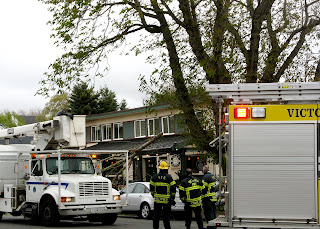









Spring made a surprise visit to Victoria yesterday, and took a look around. Hope she comes back soon.
The epicentre of downtown Victoria clusters around the Bay Centre, which is one of the few shopping malls I have been to that doesn't give me an immediate urge to flee. On the Government Street side is where the tourists like to go, and further south is the Parliament complex, hotels, offices and then the James Bay neighbourhood. All within a shouting distance of the picturesque and endlessly interesting Inner Harbour.
North of the Bay Centre, downtown gets seedier. The buildings are not as well maintained. Tattoo parlours, night clubs, comic book shops, consignment clothing places and so on abound. Then comes Chinatown which has a flavour all it's own, fragrant, too, with the smells coming from the produce shops. And after Chinatown the buildings get older and seedier, unoccupied lots are given over to parking.
Store Street is only a few blocks long and behind the building facades is the Upper Harbour where tourists seldom come. Most of the elderly structures here are of the utilitarian nature, but to me are full of charm. Advertising from fifty years ago or more is still painted on brick walls.
Capital Iron used to be an iron mongery serving the marine trade. By constantly reinventing itself it has managed to continue in business all these years. The lower floor used to be filled with artifacts from those olden days, but now all the ships wheels, binnacles and other gear is heaped up into one small corner along with all sorts of other ancient items of machinery. The rest of the floor seems taken up with hot tubs.
Down the street from Capital Iron is a prosperous kayak shop, and next to that is Victoria's Value Village, which now bills itself as the community donation centre. Personally, I can't imagine buying someones used underwear, but the place does a smashing business, especially at the end of the month when the welfare checks come out.
It's an area I am very fond of, a mix of decaying industrial era and decaying social activism. A middle aged Chinese-Canadian lady was giving a speech. I only spent a few minutes there so I really don't know what it was about. All I caught was a bit about how her ancestors were buried in the Chinese cemetery near Gonzales Bay. It's a lovely spot, situated on a flat shelf of land next to the sea with a rocky hill behind it. However, the lady was lamenting that the Chinese of those days didn't have citizenship rights and were forced to create their own schools and other social amenities. The largely white, middle-aged, guilt ridden audience nodded in solemn approval. Hmm. I wonder which she would prefer, a relatively peaceful and secure life in a prosperous country as a somewhat marginalized cultural minority, or a life in China at the same time. Let's see. There was the endemic warfare as various potentates sought to dominate the others, there was the Japanese invasion and the rape of Nanking, and let's not forget the fifty or sixty million who died during Mao's Great Leaps Forward or Cultural Revolutions. Of course, her family could have gone to Japan instead of Canada. There the Chinese are still not entitled to citizenship no matter how many generations they had been there. How about Viet Nam? Well, I seem to remember something about Boat People, mostly Chinese, who preferred taking their chances with sharks and hurricanes to dealing with Jane Fonda's buddies from the North.
Oh, yes, I forget. Only white people can be racist. It must be in the lexicon somewhere, although I've never actually seen it. For instance, when Mao got rid of all the Russian settlers who had lived for generations in Northwest China, that can't be racism because Chinese aren't white. I used to know a Russian refugee from there and he liked to talk about the forests of peach trees where he used to hunt wild pigs.
According to my own mental lexicon, racism is a human norm. Or maybe a better word would be race awareness, something we all have. That's not wrong. What is wrong is racial hatred, or if you want to use the fancy word, xenophobia. There was a positively hilarious piece in the National Post last week by a writer who had attended an anti racism education program. Run mostly by self-loathing, guilt ridden white women, it seems, they rather agree with me. There is absolutely nothing any white person can say, think, or do which is not racist, according to them. However, they see this as a sign of the incurable disease of being white, while I see it as proof that everybody has a finely tuned sense of who they are. We are different from each other. I like the French saying, vive la difference. Whether the deciding factor in the differences is cultural or genetic, I don't know, but I also like the biblical quote, "She is black but comely."
Racial and cultural clashes in the past took place mostly on the edges of geographic zones, but now that those zones have largely been obliterated, we really do have to think sensibly about these things, especially when we are confronted with an aggressively chauvinistic culture from the Middle East.















































